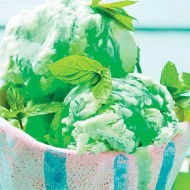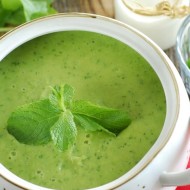Medicinal properties of peppermint, possible harm and contraindications for use
Content
Botanical Characteristics of Peppermint
About 50 varieties of mint are known, but the only officially recognized one is peppermint. It is a shrub reaching a height of 1 m. On the branches, oblong leaves grow densely. The grass blooms with lilac flowers that form inflorescences.
Medicinal and useful properties of the plant
The herb is famous for its beneficial properties on the body:
- Calming the nervous system. The plant will help to quickly relieve emotional stress.
- Pain relief of the injured area of the body. Relevant for dislocations, sprains and joint pain.
- Relief of headaches.
- Positive effect on digestion processes. In addition, the plant eliminates diarrhea, nausea and flatulence.
- Relief of colds. Removal of nasopharyngeal edema, throat pain relief.
- Enhanced brain activity.
- Toothache treatment.
- Favorable effect on the work of the cardiovascular system.

Benefits of peppermint
For women
Women use the healing properties of peppermint in a variety of ways. Most often, the herb is used in the treatment of gynecological diseases. Also, fragrant decoctions act as a sedative during periods of sudden mood swings. Creams and masks based on medicinal herbs can improve the condition of the skin: smooth out wrinkles, relieve swelling, narrow pores, eliminate oily sheen.
For men
The beneficial properties of mint for men are similar:
- Relaxation and calming of the nervous system. As a result, a sound sleep.
- Stimulation of blood circulation.
- Favorable effect on liver function.
However, in the course of an experiment conducted by American scientists, it was found that mint negatively affects potency. As a result of the frequent use of aromatic drinks, the testosterone level is significantly reduced and a man may develop infertility. This is due to the high content of female hormones - phytoestrogens.
Video "The healing properties of peppermint"
This video tells about the features of the use of a medicinal culture.
Peppermint Applications
Due to its beneficial properties, the plant is actively used in several areas.
In folk medicine
Mint, as a rule, is used in any form: fresh, in the form of decoctions, infusions, teas.
Fresh mint
Fresh twigs are used as a medicine for colds, an ingredient in cosmetics. Here are the main uses for fresh herbs:
- Toothpaste. Mint juice is mixed with baking soda and peroxide. This composition is contraindicated for owners of sensitive teeth.
- Inhalation. If you have difficulty breathing during a cold, inhalations from mint will have a quick revitalizing effect.
- Ice with leaves of grass. The mint is crushed and frozen. These ice cubes are great for keeping your skin toned.

Fresh twigs are used as cold medicine
Dried mint
Decoctions, teas, and alcoholic tinctures are prepared from dried peppermint. They are irreplaceable in case of problems with the digestive tract, infectious diseases. Decoctions are also used to treat wounds and rinse the mouth with bleeding gums.
Extract
Menthol extract can be purchased at any pharmacy. The tool has anesthetic, anti-inflammatory, antibacterial effect. The extract is added to solutions for inhalation, applied to the area of the temples for headaches.

Menthol extract is added to inhalation solutions
Mint tincture
Tincture based on alcohol and peppermint helps against pain in rheumatism, injuries, viral diseases. In addition, peppermint tinctures have a calming effect and help relieve insomnia.
To prepare the tincture you will need:
- mint leaves - 1 tbsp. l .;
- boiling water - 200 ml.
The leaves are poured with boiling water, poured into a thermos and insisted for about an hour. For greater heat saving, the container is wrapped with a blanket. After this time, the composition must be passed through cheesecloth.
The medicinal drink is taken three times a day in small sips.
Alcohol tincture
To prepare an alcoholic tincture, you need to pour the dry leaves with alcohol. The liquid infused for 2 weeks is applied to the back of the head, temples for migraines. Alcohol tincture does not lose its properties for 1–1, 5 years. Store the container with liquid in a cool, dark place.
Peppermint oil
The main property of the oil is its antibacterial effect. Therefore, ether is often added to baths, aroma lamps, and creams. The tool relieves inflammation of the gums, fights against a runny nose and swelling of the nasopharynx, relieves headaches.
For problems with the digestive tract, a few drops of oil are added to kefir.
Peppermint decoction
Mint broth is taken for heart disorders, dermatological diseases, nausea. The tool effectively copes with depressive conditions. To prepare the broth, pour boiling water over the dry leaves, leave for 15 minutes and drink twice a day, sip. It should be borne in mind that this drink is stored for only a day. After this time, the useful qualities of the broth disappear.

Mint decoction effectively copes with depressive conditions
In cosmetology
Compositions for leather
Regular use of mint compositions for the skin of the face will significantly reduce the number of wrinkles, relieve inflammation and swelling, and eliminate acne. Also, the medicinal plant will help get rid of age spots and have a lifting effect on the skin.
Peppermint oil is actively used in the teeth whitening process. To do this, just drip a little oil into the toothpaste.

Hair formulations
The use of mint for hair normalizes metabolic processes in the scalp, activates growth, and controls the production of sebum.
To prepare a nourishing hair mask, you need to combine 1 tbsp. l. coconut oil, egg yolk and 3 drops of ether. Such masks will restore damaged hair, make it manageable and shiny.
In cooking
The aromatic herb often becomes a natural flavoring agent for meat and fish dishes. Fresh grass leaves are put on cakes, pastries, cottage cheese desserts, ice cream. In addition, mint is one of the ingredients in many spices, including Provencal herbs.
Contraindications and possible harm
To refrain from using aromatic herbs should:
- people suffering from varicose veins;
- infertile women;
- hypotension;
- people whose activities require attention.
It is not recommended to use mint for children under 13 years of age.
For pregnant women, the plant can help cope with toxicosis, constipation, flatulence, swelling of the throat. However, in the case of uterine tone, you should refrain from eating mint. During breastfeeding, drinks containing fragrant leaves should not be consumed, as they can reduce milk production.
Rules for the procurement of raw materials
To prepare high-quality raw materials, you must follow simple recommendations:
- Sprigs should be collected in the first days of flowering. It is during this period that the plant has the maximum amount of useful elements.
- You need to harvest raw materials in dry weather.
- The twigs are tied with a thread in bundles and hung in a ventilated place, reliably protected from the sun.
- Dry twigs should be stored in glass containers.
Mint is a multifunctional remedy that has a beneficial effect on the general condition of the body. However, improper use of the herb can cause health problems. Therefore, before using decoctions, teas and tinctures based on fragrant twigs, it is necessary to study the contraindications to the use of mint.



